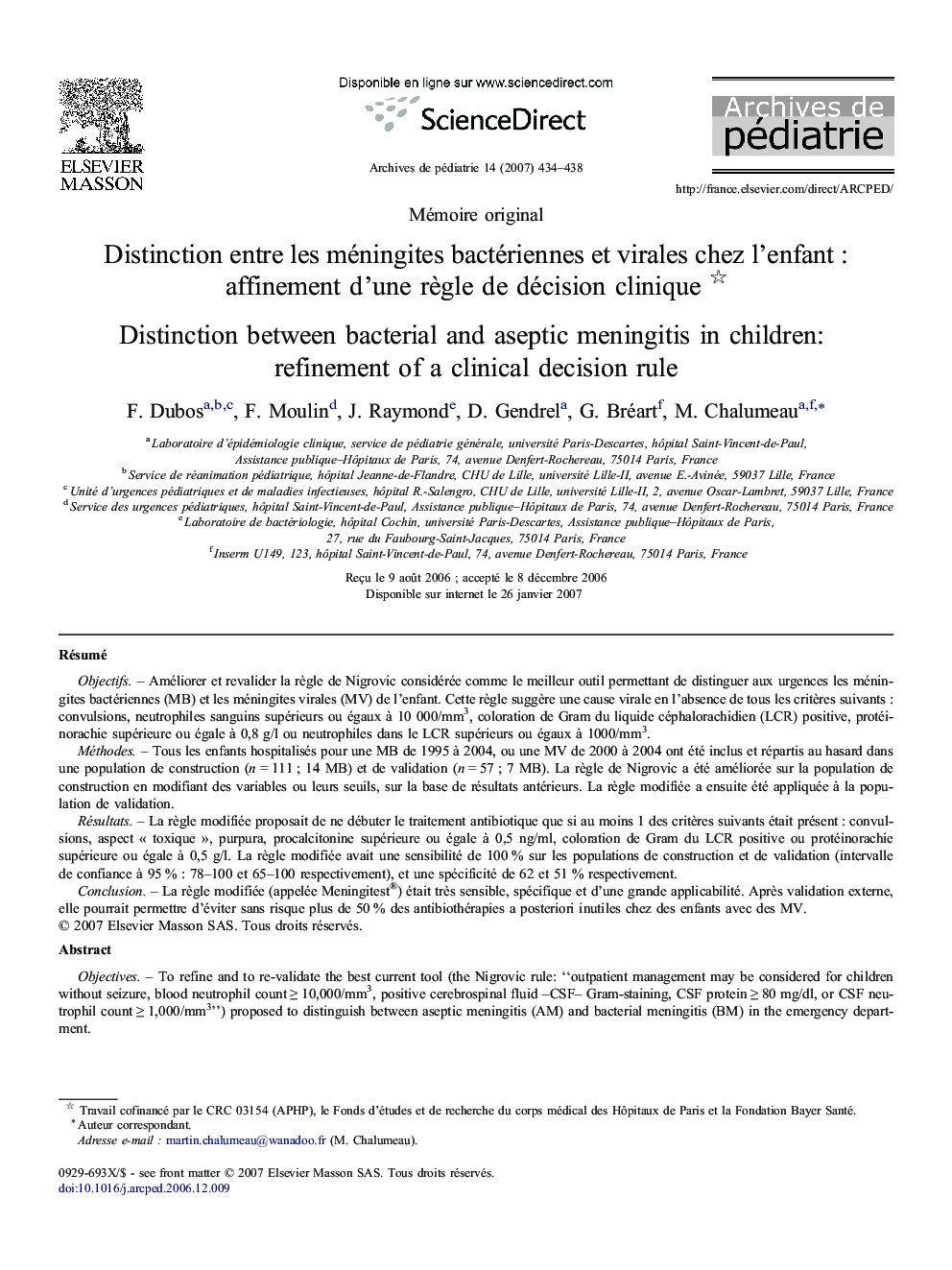| کد مقاله | کد نشریه | سال انتشار | مقاله انگلیسی | نسخه تمام متن |
|---|---|---|---|---|
| 4149988 | 1272764 | 2007 | 5 صفحه PDF | دانلود رایگان |

RésuméObjectifsAméliorer et revalider la règle de Nigrovic considérée comme le meilleur outil permettant de distinguer aux urgences les méningites bactériennes (MB) et les méningites virales (MV) de l'enfant. Cette règle suggère une cause virale en l'absence de tous les critères suivants : convulsions, neutrophiles sanguins supérieurs ou égaux à 10 000/mm3, coloration de Gram du liquide céphalorachidien (LCR) positive, protéinorachie supérieure ou égale à 0,8 g/l ou neutrophiles dans le LCR supérieurs ou égaux à 1000/mm3.MéthodesTous les enfants hospitalisés pour une MB de 1995 à 2004, ou une MV de 2000 à 2004 ont été inclus et répartis au hasard dans une population de construction (n = 111 ; 14 MB) et de validation (n = 57 ; 7 MB). La règle de Nigrovic a été améliorée sur la population de construction en modifiant des variables ou leurs seuils, sur la base de résultats antérieurs. La règle modifiée a ensuite été appliquée à la population de validation.RésultatsLa règle modifiée proposait de ne débuter le traitement antibiotique que si au moins 1 des critères suivants était présent : convulsions, aspect « toxique », purpura, procalcitonine supérieure ou égale à 0,5 ng/ml, coloration de Gram du LCR positive ou protéinorachie supérieure ou égale à 0,5 g/l. La règle modifiée avait une sensibilité de 100 % sur les populations de construction et de validation (intervalle de confiance à 95 % : 78–100 et 65–100 respectivement), et une spécificité de 62 et 51 % respectivement.ConclusionLa règle modifiée (appelée Meningitest®) était très sensible, spécifique et d'une grande applicabilité. Après validation externe, elle pourrait permettre d'éviter sans risque plus de 50 % des antibiothérapies a posteriori inutiles chez des enfants avec des MV.
ObjectivesTo refine and to re-validate the best current tool (the Nigrovic rule: ‘‘outpatient management may be considered for children without seizure, blood neutrophil count ≥ 10,000/mm3, positive cerebrospinal fluid –CSF– Gram-staining, CSF protein ≥ 80 mg/dl, or CSF neutrophil count ≥ 1,000/mm3’’) proposed to distinguish between aseptic meningitis (AM) and bacterial meningitis (BM) in the emergency department.MethodsChildren hospitalized for BM between 1995 and 2004, or AM between 2000 and 2004 were included, and randomly divided into derivation (111 children, 14 BM) and internal validation (57 children, 7 BM) sets. The Nigrovic rule was refined on the derivation set, introducing new variables (purpura, toxic appearance and high serum procalcitonin), changing variables thresholds (CSF protein) and withdrawing some variables (blood neutrophil count, CSF neutrophil count), according to previous results, with the aim to obtain 100% sensitivity user friendly tool. The refined rule was then applied on the internal validation set, stayed blinded during the derivation process.ResultsThe refined rule was: start antibiotics in case of seizure, purpura, toxic appearance, procalcitonin ≥ 0.5 ng/ml, positive CSF Gram-staining, or CSF protein ≥ 50 mg/dl. The refined rule had 100% sensitivity on the derivation and the internal validation sets (95% confidence interval 78–100, and 65–100, respectively) with 62 and 51% specificity, respectively.ConclusionThe refined rule (called Meningitest®) was a highly sensitive, specific and user friendly tool that could allow to safely avoid > 50% a posteriori unuseful antibiotic treatments for patients with AM.
Journal: Archives de Pédiatrie - Volume 14, Issue 5, May 2007, Pages 434–438